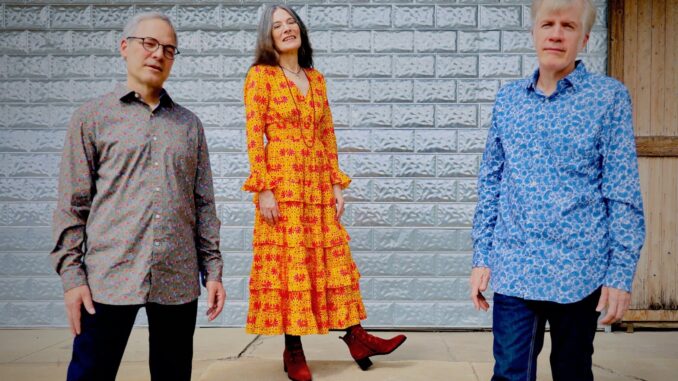
The term mutant folk seems to fit.
In the band’s early days, before The Victor Mourning emerged from the pupa into an adult Swarme of Beese, their songs elicited unusual receptions. Co-songwriter Lynne Adele recalls performing on the music stage at the Austin, Texas, airport. “We were banned from playing out of concern for the mental well-being of nervous flyers. I guess they thought our songs would make people start panicking or something. But once at a show in West Virginia, an audience member thanked us afterward and said they’d booked an appointment with their therapist during the break. You know, it’s great to get that kind of feedback that lets you know people are actually listening.
Wouldn’t it be interesting to have been a fly on the wall during that therapy session? At the risk of disregarding the don’t-ask-don’t-tell adage, I found the news item for the release of TVM’s “A Handful of Locusts”: “Ancient American & British ballads, pre-WWII hillbilly music, abandoned shopping centers & empty swimming pools, scythes, cemeteries & odd museums, the smell of old books, gasoline & matchbooks, jewelry made of human hair, and the broken shores of Patagonia.”
The first song – ‘Kill a Spider (Frankie Silver)’ – on the self-described gothic country band’s album was based on the true story of a woman who murdered her husband in 1831 and was subsequently hanged. That set the tone, for which the renamed Swarme of Beese has adhered to through three albums: “Backwoods of My Mind,” Fruits of the Golden Land”, and their latest, “Waiting for a Sign.”
The band is comprised of Lynne Adele and husband Stephen Canner sharing vocals and guitars, with Stefan Keydel on fiddle and assisted by producer/multi-instrumentalist Mark Addison. On “Waiting for a Sign,” Canner writes most of the songs, Adele contributing three with one other a co-write. They now depict their songs as hillbilly noir, which rings true, and Canner’s vocal style reflects the darkness in that label, whereas Adele’s gentler tones might be termed as hillbilly légère. Keydel complements each vocalist with his expertise playing fiddle and viola. Their description of what the latest album represents is a “collection of sonic postcards from an allegorical road trip through the back roads of the American landscape, with detours to haunted places where memories and dreams intersect.”
Sounds eerie. Whatever they wish to call it, Swarme of Beese (note a reluctance to use the acronym) has an uncanny knack for scoping out unique and provocative stories. Adele has an art history degree, and Canner is an avid reader. This inevitably colours their songwriting. Poetic lyricism being a necessary aid to their telling of the fantastical journey through the psyche and beyond.
Their albums are packed full of that seamless, collaborative energy, melancholic musings, intense soundscapes and the devastating lyricism of an Elliott Smith. The art on their album covers is as uncanny as the vivid sonics, strange enough to fit into the world Adele crafts in her ever-dramatic dreamscape.
“We enjoy working with artists we know,” she acknowledged. “Nick Scoulios created the complex analog photograph using layered transparencies on “Backwoods of My Mind”, and we commissioned Dan Barry to create the mixed media collage reinterpretation on an original Currier & Ives chromolithograph for “Fruits of the Golden Land.” Once we have a basic concept and images for a cover, we work with our friend Will Branch, who designed all three Swarme album covers.”
They are quick to disabuse any notion of genre, including the broad palette of americana. “We think our music is fairly accessible,” Canner asserts, “but a lot of people seem to find it difficult or strange. We identify as being on the folk end of the acoustic americana spectrum, but in our experience, traditional folk outlets haven’t recognized us as folk. We’ve felt like outsiders for a long time, and so we’re just sort of embracing that, and the term “mutant folk” seemed to fit.”
Their producer, Mark Addison, believes Swarme of Beese are historians, scholars who delight in plumbing the darkest regions of American folklore and the upturning of history that we see today. “They’re folkies because of the instruments they play, but I’m convinced their ideology is closer to punk rock. I’m sure they’d prefer to listen to Pere Ubu than Woody Guthrie. And they’re not afraid of adding crunchy kick drums, fuzzy guitars or people banging on things to their otherwise sparse sound. Working with them has been a total creative mindbender. And they’ve confirmed again to me that there is more poetry in the darkness than there is in the light.”
If there is a progression after The Victor Mourning, it’s not readily apparent, maybe in the margins, maybe in aging, where you begin to think you have more of a handle on things than you thought. To this listener, songs like ‘Jesus Came from Tupelo’ and ‘Crown of Wire’ off Backwoods, and ‘Cellar Door’ and ‘Ashes & Holy Water’ from Fruits are interchangeable with ‘Christmas Truce’ and ‘Tribulation Valley’ on Waiting. But the impression you get is that’s not necessarily accurate, and you will discover why in the following interview with all three members of the band.
Americana UK: How would you describe the differences between “Waiting for a Sign” and your previous two albums?
Lynne Adele: I think each album has a distinct feel, but there’s also a cohesion. The recordings are influenced by everything that’s happening in the moment when we record them, how we’re feeling that day in that particular environment, and how our producer, Mark Addison, responds to them, because that’s the first time he’s heard the songs. If we recorded them today, I suspect they’d sound quite different. Then, when you group them together, it creates something else. Maybe “Waiting for a Sign” feels more contemplative than the others? There seems to be a bit of life review going on in these songs. I think it’s pretty obvious that they’re not written from the perspective of youth.
Stephen Canner: When we started recording “Backwoods of My Mind,” which began as a project for The Victor Mourning, we hadn’t released an album in over a decade. For the most part, it was older material that we hadn’t yet recorded. Just after we went into the studio, COVID hit, and we all went into isolation.
LA: We were even separated from our guitars for months. We’d just dropped off Steve’s Martin and his 1970s Hummingbird that I’d been playing for maintenance when everything locked down. Somehow, we ended up with Stefan’s lovely custom Allison — I think Steve had played it on a track — and it was months before we were all reunited with our own guitars.
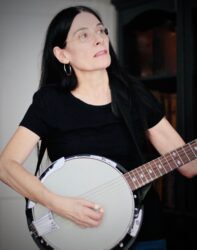
SC: When we returned to the studio about a year and a half later, we had retooled as Swarme of Beese. In many ways, I see “Backwoods” as a transitional album in that it reflects our “hillbilly noir” roots as The Victor Mourning, but also shows that the band was growing organically into whatever it’s still in the process of becoming.
Lynne had written a bridge and a verse and improved some lines here and there on a couple of songs on “Backwoods”, but with “Fruits of the Golden Land,” she emerged as a songwriter. It was quickly apparent to me that this was something that had been lying dormant for far too long. ‘Year of Dickens,’ ‘Ashes & Holy Water, ’ and ‘Goldie Pearl (Little White Dress)’ were some of her earliest songs. They simply appeared, as if she’d been writing for decades.
“Fruits” also represents the first time Lynne and I began truly co-writing songs together from scratch with ‘Cellar Door.’ But as a complete body of songs, it has a tighter thematic cohesion than the other two albums. We see it as a metaphorical road trip across this country. The songs are musical postcards that tell little stories at stops along the way.
Our most recent album, “Waiting for a Sign,” began as an idea for a winter-themed single. We kept writing new material, though, and before we knew it, we were recording another album. I think the title and the wintry theme reflected not only our current state of mind, but also where we are globally in this cultural and historical moment — in a state of stasis, waiting for peace, for sanity, for a stability that may never arrive. The last track on the album, ‘Tribulation Valley,’ sort of sums it all up. We watch in disbelief and denial, passively waiting for answers and the final reckoning that ultimately, we’re all to blame for where we’re at.
AUK: You have been playing shows in old halls. What caused Lynne to have interest in them, and how did David Byrne become aware of it?
LA: I’m an art historian and have a fairly extensive writing background. I’ve long been intrigued by the beauty and mystery of antique fraternal objects. My friends Bruce Lee Webb and his wife Julie have owned an art gallery in the Dallas area for years and are longtime collectors of lodge hall paraphernalia. Bruce has an extensive library of antiquarian fraternal books.
In late 2011, Steve and I attended a talk Bruce gave, and afterwards I asked him to recommend a book about fraternal objects. I was surprised that there wasn’t one, and pretty quickly, I got the idea that he and I should write it. It ended up being a 2½ year project, a beautiful art book with lots of historical background for a general audience. Bruce and Julie know David Byrne — I believe they met when he was in Texas working on “True Stories”-and introduced him to fraternal objects. Of course, we were delighted that he agreed to write the foreword. The book is now in its third printing.
SC: When COVID hit, we stopped playing out; Lynne and I got used to isolating and staying out of crowds. We’ve released three albums since, but these will be our first shows since 2019. Austin has around 250 live music venues and an infinite number of bands, which is great for audiences but less so for musicians. Our music is quiet, and we wanted to do something more satisfying than competing with people’s conversations or hissing cappuccino machines. So, this thematic mini-tour idea came up, rooms we’d like to play that held a deeper meaning for us, highlighting the spaces themselves and becoming part of their history at the same time. The fact that they’re in out-of-the-way locations makes it even more appealing.
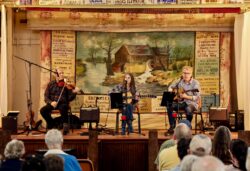
AUK: Is the occult or the supernatural, macabre, fear, death tied to what you term as in the style of American Gothic? How would you define mutant folk if you accept the premise that all music is folk music?
LA: We generally dislike the concept of genres and labels, but you have to call it something. The americana umbrella is so broad that it can include just about anything. The Victor Mourning songs were dark and rooted in Appalachia, and Steve coined the term “hillbilly noir” to describe that southern gothic aesthetic.
SC: By the time we came back to Texas, our sound was already evolving, and when we started working with producer Mark Addison, he guided us further in the direction we wanted to take. He’s played a very important role in how we sound and think about our music.
The Victor Mourning wasn’t where we were anymore, and while some of the songs still were very southern and gothic, they were becoming more broadly American somehow. We changed the name of the band to reflect this new direction.
AUK: For promoting your shows at the three historic fraternal society lodge halls, where did you find the goat tricycle in the Ride the Goat image? And why is the rider blindfolded?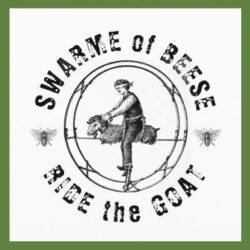
LA: That particular lodge goat resides at Ernest Hüpeden’s Painted Forest, a defunct Woodsmen of America lodge in the village of Valton, Wisconsin, about 90 minutes from Madison. The mechanical goat would have been used at initiation ceremonies. It stems from a 19th-century urban legend that Masonic initiation rituals included riding an actual live goat. Over time, “riding the goat” became popular slang for joining a fraternal society. These mechanical goats were produced for some of the less serious groups and were used for hazing new members. Some even had attachments that would squirt water or deliver an electric shock to the blindfolded rider. The one on our tour logo is from a 1909 catalog of fraternal paraphernalia, and it looks pretty great on our tour t-shirts.
AUK: Is your tour vehicle really a working hearse as it appears on your Facebook?
LA: Only conceptually! When we saw that hearse sort of permanently parked at an abandoned gas station, it looked like a good place to stretch our legs and grab a cold drink on the metaphorical road trip of “Fruits of the Golden Land.”
AUK: What were you doing during that 7-year exile in Appalachia?
LA: Steve began working for Apple from home around the time we met, and that opened up the possibilities of where we might live.
SC: We both needed a break from Austin, so we visited Maryville, Tennessee, just south of Knoxville, in late 2011. We fell in love with the Great Smoky Mountains and bought a house there within 24 hours of arriving.
LA: Steve completed his master’s degree in rare book librarianship at Kent State, and I wrote the fraternal art book during that time. It was pretty intense — he was working full-time, in grad school full-time, and interning at the Maryville College library on the weekends. He’d get up at 4 am every day to get it all done. Somehow, in the midst of all that, we managed to do a lot of traveling throughout the eastern US. It was a great 7 years, and we miss the natural beauty and climate of that region.
SC: Musically, we did a little playing out as a duo and released a digital single, two songs that we recorded there, originally intended for the Folk Police label in the UK, just before they folded.
LA: We refer to that as “The Victor Mourning Effect.”
AUK: Is there a particular painting that Lynne very much identifies with?
LA: That’s a tough question! My degrees are in art history, and I worked in an academic art museum for a long time and then at an art gallery, so I’ve seen a lot of art. Two artists whose work I’ve been drawn to are Eddie Arning, who struggled with mental health issues and was a patient in the Austin State Hospital for many years, and Frank Jones, who created his art while a prisoner in the Texas prison system. Both were self-taught and began making art in the 1960s, during the final years of their lives. Their work has taught me a lot about the uniquely human impulse to process our experiences through creative expression, how those expressions are the most powerful when we use our own, authentic languages, and how they can evolve over time, and that definitely includes music.
AUK: For Stephen, the same question, replacing painting with books.
SC: I also find this question difficult to answer, as there are so many candidates. There are a couple that spring to mind, though. The first would be Bruce Chatwin’s “The Songlines” from 1987. Chatwin was a huge influence on me in my 20s and 30s, and this book was one of the reasons why. Besides the fascinating idea that gives the book its title — the idea that traditional songs can literally be used as maps to navigate the landscape — what resonates with me is the way that much of the book is written in seemingly completely unrelated anecdotal fragments. At first, this seems a bit confusing, but as you read through them, an interconnectedness emerges.
The other one I would include is Iain Sinclair’s “Lights Out for the Territory,” also from 1997. He showed how a place — in this case, London, the subject of most of his writing — can be “read” as a container of information in ways previously unexplored. This can mean the literal reading of posters and graffiti, but also includes deeper research that can lead to unexpected connections, like how did this pub on the corner, where gangsters were known to hang out in the 1960s, relates to William Blake? With this book, Sinclair pioneered a radical new approach to “reading” the environment—a sort of avant-garde cultural archaeology—that has consciously or unconsciously informed my own writing for decades now.
AUK: Did the person who did your artwork on “Waiting for a Sign” have input from the band? Is there a particular thread that connects the music to the cover art, since you have a winter scene and what looks to be a fallen autumn leaf?
LA: The album was released as a CD only. It was originally going to be a single — ‘Christmas Truce’ with ‘10,000 Frozen Lakes’ as the B-side. I’d seen some of Ray Colby’s photos online. He’s a Minneapolis-based photographer who happened to have been a high school classmate of mine many years ago, and he sent me some images. We kept writing songs, and it turned into a full album, but Ray’s photos still worked with the new songs, and winter is traditionally the season of waiting. The title is a line from the song ‘Tribulation Valley.’ We love the leaf image — that brief moment of transition between seasons — you open the CD cover and there’s this visual treat, a vivid reminder that something unexpected can be found just beneath the surface, even in the bleakest winter, if you take the time to look.
AUK: What type of music/musician was each of you affected by before deciding to pursue music as a career?
LA: First of all, we wouldn’t call what we do a “career,” but rather a never-ending art project. My dad had been a touring musician before I was born and had a degree in music, and my mom had briefly sung and played upright bass in a combo they had when he was in college. So, music has always been an important part of my life. My interests are broad, but I’m hyper-sensitive to loud noises, so I’ve tended to gravitate towards acoustic music. I’m drawn to great lyrics and strong vocal harmonies, so Dylan, Neil Young, The Byrds and then Gram Parsons and Emmylou Harris; later, Gillian Welch and David Rawlings, who walk on musical water. Songwriters like Chris Knight, who tell great stories, and Robyn Hitchcock, whose songs allow you to glimpse the inner workings of his brilliant mind. I can think of a number of songwriters who have written a song so powerful that they could just stop right there and still be great, because they created that one song, a single, small masterpiece that does everything it needs to in 5 perfect minutes.
SC: My standard “origin story” is that in my earliest years, I was deeply drawn to both Johnny Cash and Black Sabbath. This is literally true, but the bigger point is that while I very much appreciated and embraced the country music I heard growing up, I was also very open to other things. In my pre-teen and early high school years, this meant The New York Dolls, Alice Cooper, and Bowie. Punk and new wave emerged when I was in high school, and I was immediately drawn to it. In retrospect, I realize that part of this was youthful rebellion, but more importantly, it was a creative antidote to all the horrid arena rock that was so prevalent at the time. By my mid-20s, I discovered that country music had a pre-history of sorts and became very obsessed with pre-war hillbilly 78s. My interest there was both aesthetic and scholarly. I would spend hours in the Folklore Collection of the Indiana University Library poring over back issues of “Old Time Music” magazine as well as collecting both reissue LPs and original 78s when I could find them. Simultaneously, I became more and more interested in 60s garage and psychedelic rock, as well as the hidden history of American music that could still in those days be found on small label 45s lurking in the record bin of your local thrift store. Looking back now, I think these twin streams of hillbilly music, in all its forms —from the primitive to the polished —along with the creative explosion that occurred in the 1960s, especially in local scenes and on smaller labels, are my most enduring influences.
Stefan Keydel: Although I’ve performed in a kind of semi-professional capacity over the years, I wouldn’t call it an actual career. Perhaps when I retire. But as far as influences are concerned, goodness! Of course, The Beatles, but also Wire, Kraftwerk, Eno, 70’s Bruce Springsteen, The Skillet Lickers, Charlie Patton, Devo, Throbbing Gristle, Buffalo Springfield, Mahler, Funkadelic, Big Star . . . I could go on, of course.
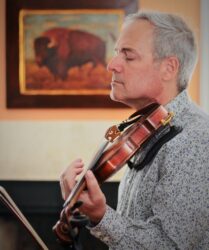
Americana UK: What would each of you have done for a career if not the band? Or do you have other careers?
LA: I worked in the education department of the art museum at The University of Texas for 15 years, and then at an Austin art gallery, Yard Dog, for about 8 years. Americana music enthusiasts might know Yard Dog for its epic, unofficial SXSW day parties, and I met many musicians there.
SC: As Lynne mentioned, since the late 1990s, I’ve worked for Apple. It’s a great place to work, and I do like my job, but if I had it to do over, I’d pursue an academic career.
SK: I did aspire to make a career of music in my early twenties, but I suppose I never had the gumption to put all of my eggs in that basket. In the meantime, I’ve done everything from working on a fishing boat in the Bering Sea, framing houses, bicycle messaging, working as a folklorist, to finally arriving at a career in data science.
AUK: How did the band form? Who was the one to recruit the other, or did it happen another way? When did Stefan come into the picture?
LA: It was in Austin, so it was only appropriate that Steve and I met during SXSW. This was in 2008, at Yard Dog, the gallery where I was working, which was then sort of Ground Zero of SXSW unofficial day parties. I happened to be feeling just extroverted enough to engage in a conversation with a random stranger I’d just been introduced to. He showed up again the next day during the Bloodshot Records party and mentioned that he was a singer-songwriter wanting to put a band together. I told him that if he was looking for a harmony vocalist, I might be interested, and a month or so later, we played together for the first time. That was the beginning of The Victor Mourning, but we still needed a melodic lead.
SC: I met Stefan through mutual friends at Apple, where we both work, and he had played with me on a gig or two over the years. So, when it came to add a melodic lead, he was the first person who came to mind. Originally, he committed to doing three gigs we had lined up for the fall of 2008, but by the end of the year, we were happy to hear that he wanted to become a permanent member.
AUK: What piece of advice have you gotten from someone that stuck with you?
LA: I can think of one piece of advice that we received and had no interest in taking — “Follow the money.” We weren’t interested in following money. We just wanted to follow our own vision and make music, but I can’t recall anyone ever saying we should do that. The song ‘Burn That Bridge Down’ is about advice. People often tell you not to burn bridges, but sometimes drastic measures are called for, and some bridges are meant to be burned if you’re going to move forward.
SC: I find that most people giving advice have such a different worldview than I do that I try not to listen. Most people want to tell you how to succeed financially. But what about aesthetic and creative success? At the risk of excavating a cliché, I think Joseph Campbell’s directive to his students to “follow your bliss” is great advice. But the way I interpret it is not just to follow a career path that best aligns with your interests, but to do whatever you love to do because it is part of who you are. Do it for its own sake.
AUK: Does most of America live in the surrealistic horror of your tales and just don’t know it?
LA: I’d say that America as a whole is living in a surrealistic horror right now that doesn’t have anything to do with our songs.
SC: If they don’t know it, they’re just not paying attention.
AUK: What song from Backwoods would you say is representative of that album and why?
SC: I wrote ‘Singing in the Dark’ during a time when it seemed that finding a truly, deeply compatible partner was something of a pipe dream. Lynne and I started out as musical colleagues and became friends, but quickly began to discover a deep connectedness that neither of us had ever experienced. There’s something about remembering writing the song alone on the couch with my Gibson Hummingbird and then hearing it emerge as a shared artistic expression that reminds me of the magic of the creative process. The album only happened because the situation the song suggested in the first place was answered by meeting not only my life partner, but my life’s creative partner.
LA: For me, it’s the title track, ‘Backwoods of My Mind.’ The process of making that first album with Mark Addison at his studio on the outskirts of Austin was a real awakening and a learning experience that has changed the way we think about our songs. His influence and contributions can’t be overstated. Besides being an extremely skilled, experienced producer and a talented multi-instrumentalist with great instincts and a deep knowledge of music, he’s also an accomplished songwriter. Working with him has really helped us to see the potential of our own material. He’s produced all three Swarme albums, and now, when we write songs, we always imagine what they might sound like with Mark’s production.
SK: Man, I love every song on that record (shocking, I know!), but I’d have to pick the title track, ‘Backwoods of my Mind’ as, in my mind, it seems to incorporate elements of both where Swarme of Beese has come from as well as where it’s evolving to. Because, while Swarme of Beese is grounded in Stephen’s southern gothic/hillbilly noir aesthetic, we’ve now begun incorporating more of Lynne’s songs, which tend to be less evocative of fascinating characters and liminal settings as dreamed up via Stephen’s fertile creativity and more evocative of her lived experience, all the while hewing to the Swarme of Beese sensibility.
AUK: Let’s go for the same question with “Fruits“.
LA: It’s hard for me to separate the songs from everything that was going on at the time. I wrote ‘Year of Dickens’ during COVID lockdown. I was trying to read Charles Dickens’ “A Tale of Two Cities,” his novel about the Reign of Terror following the French Revolution, and started writing the song the day I heard that Justin Townes Earle died. I remembered seeing him perform — so much lost potential. The song is a lament for those times, the months of angst and uncertainty, the opioid crisis, poured into one 3-minute song. Then my mom died not long before we recorded it. I hear all that in my fragile vocal, almost at the breaking point, enveloped by the delicate instrumental arrangement created by Steve and Stefan, with Mark’s ominous bass and my sweet little 1920s Stromberg-Voisinet parlour guitar in drop-D tuning.
SC: I wrote ‘Distant Father’ in my earliest days in Austin and immediately felt that it embodied what I was trying to put across with my songwriting. I believe it was the first song I ever played for Lynne. Just a few weeks ago, she mentioned that she had reworked it into a version from the woman’s point of view, but she wasn’t ready to play it for me. Then one morning, while I was scrambling some eggs, she began singing her version in the other room. I rarely have this sort of immediate, deep response to music, but I was just pulled out of my reality right into the song. It was like my heart filled with warm honey and then dropped out of my chest and onto my feet. She took a lyrical, slightly dark folk song and made it darker, but at the same time, filling it with passion, urgency, sexuality, and soul. We haven’t recorded her version yet, but I can’t think of this song in any other way now.
LA: I’ve always seen that as Stephen Canner’s signature song, and I think the recording is beautiful. It felt weird to be tampering with it; it just happened by accident one day when I was home alone. I thought he might find it interesting, but it sounds a lot different, and I worried that he might think it strays too far from his original intent.
SK: I’m going to go with ‘Distant Father,’ not because it’s necessarily the most representative of the album, but because it’s just a brilliant work of art. Here on this black earth, there’s no room to dream / Just look at the world and you wonder / Black dirt and blue eyes and old songs to sing /Wait for the sound of far thunder. I mean, come on! And it’s another song that represents our journey (and I hope I’m not giving anything away prematurely). Lynne has reworked it from the perspective of the person to whom the original is sung, and this is the version we’ll be performing on our upcoming tour.
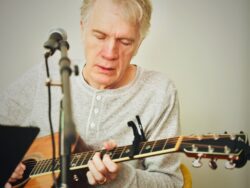
AUK: Is there some connection of ‘Guntown Mountain’ to a Kentucky theme park with its wild west dramas and freak shows?
SC: In the 1980s, I was living in Bloomington, Indiana, and my mother lived in rural southern Kentucky, near Bowling Green, where she worked assembling Corvettes. To get to her house, I would take I-65 to the Cave City exit. The most prominent feature at that interchange in those days was a huge billboard atop Guntown Mountain, luring the tourists in. Of course, it’s not a mountain at all, but in the local parlance should more properly be called “Guntown Knob.” In any case, one day I noticed the ski lift, which my family always called a “sky ride”, going up the mountain, and it seemed like an ideal setting for a fictional modern murder ballad. If you’re not familiar with the recent history of the site, you should Google it. It’s a tale of misfortune and madness.
AUK: Would you take us through some of the songs on “Waiting for a Sign” as to their meaning or inspiration, where the idea came from, the story behind the song, anything really you would care to say?
LA: “Tribulation Valley” started with an idea. I’d been wanting to write a song about the climate and environmental crisis — something with a reference to end times, not biblical end times, but the human-created ones. A lot of the imagery comes from John of Patmos’ apocalyptic acid trip called the Book of Revelation, and a couple of the verses were written as a spontaneous call-and-response. Steve would sing a line, I’d answer with something off the top of my head, and we’d scribble it down. I’m playing the acoustic rhythm guitar, with Steve on lead, which is pretty much our modus operandi these days. It really came together in the studio when Mark suggested that Steve replace his acoustic lead with an electric guitar. Recording it was a real catharsis. The coda at the very end of the song was Steve’s idea. It’s also the dramatic climax of the album with the Choir of the Damned marching off into the hell of their own creation, while Stefan channels Satan serenading them on the violin and the world ends.
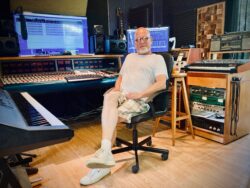
SC: ‘Christmas Truce’ was inspired by the truces that occurred during the first two Christmases of the First World War. I think my original vision was that it would be something of a dark Renaissance dance tune. The inspiration certainly came from reading about the event, but I’m sure that The Zombies’ ‘Butcher’s Tale (Western Front 1914)’ was probably lurking somewhere in the back of my mind.
I’ve long been fascinated by event songs that become part of folklore, especially murder ballads, and the real stories that inspire them. ‘Kill a Spider’ was inspired by the story of Frankie Silver, who was 16 when her husband was murdered with an axe in rural North Carolina in 1831. She was hanged for the crime at the age of 18. Her motives remain a mystery, but one of the more believable theories is that she was an abused wife who had simply had enough, which is the basic angle I approached it from.
SK: As with all of the Swarme of Beese albums, our producer, Mark Addison, played a huge role in taking the parts I had developed in rehearsal and then making suggestions as to how to improve them and have them dovetail with the aesthetics of the individual songs. This is especially apparent on the first track, ‘Gone on the Wing,’ where he came up with the pulsing string chops in the bridge. Unexpected and brilliant.
AUK: Has anything resembling the colourful stories you tell in your songs ever happened to either of you? If so, would you tell the story?
LA: ‘Goldie Pearl (Little White Dress),’ a bonus track on the CD version of “Fruits of the Golden Land,” is based on a tragic story I uncovered while doing genealogy research, trying to identify my father’s birth parents through DNA. Goldie was just 14 years old when she died following an unsafe abortion. Steve helped me put some of the pieces together, and I imagined how it all might have gone down, with the geographical features of southern Missouri becoming metaphors for the secrets buried there with Goldie.
SC: The second verse of ‘Cellar Door’ is inspired by something that happened to a good friend of mine when he was visiting his family, who lives in a holler deep in Eastern Kentucky. My friend was just along for the ride, but the basic elements are true.
‘Turpentine’ was inspired by a trip to the Okefenokee and reading Harry Crews’ “A Feast of Snakes.” It’s a twisted piece of pure fiction, and combines the hillbilly noir with a nod to psychedelia, driven home by the flange effect in the bridge.
LA: ‘Color of the Song’ is the most personal song I’ve written, or at least it feels the most revealing. It’s inspired by a memory of a sultry Austin night when some sort of air inversion charged the atmosphere with an intoxicating blend of aromas from Tex-Mex restaurants, automobile exhaust fumes, and live music. That sparked a romantic awakening that changed my life.
‘Spaces in Between’ began with a deep research dive into 19th-century American lunatic asylums. Around that time, we were planning a road trip from Texas to southern Appalachia for our wedding anniversary, and Steve surprised me with reservations at the Blackburn Inn in Staunton, Virginia, built in 1828 as the Western State Lunatic Asylum.

SC: We arrived after dark, and the next day we explored the grounds and unrestored, crumbling buildings, and discovered the cemetery where 2,500 former patients are buried. It’s very eerie — rows of identical stones, marked only by patient number, many of them eroded over time. Lynne began digging into the histories of some of the patients and the reasons for their confinement, and the song also contains a couple of references to the poet McDonald Clarke, who died in a New York lunatic asylum in 1842.
AUK: If you had to choose one song to listen to from the Library of Every Song Ever, which one would it be and why?
LA: Only one!? Right now, I’d say ‘Howdy Howdy’ from the “Woodland” album by Gillian Welch and David Rawlings, a song that grabs me from that very first note on the banjo and doesn’t let go. But also, Robyn Hitchcock’s ‘Flanagan’s Song’ from “Spooked.” When I die, just send me off to wherever I’m going with those two songs.
SC: The first thing that comes to mind here for me is ‘Smyrneïko Minore’ by Greek-American singer Marika Papagika. When I think of the Music of Eternity, I tend to gravitate towards deeply emotional music that is still abstract enough that it stands up to repeated listenings. This track — two versions of which exist, recorded in 1918 and 1919 respectively — just immediately pulls me into another dimension, one made of pure feeling and emotion.
SK: ‘What Goes On’ by the Velvet Underground. This is the song I want performed someday at my celebration of life, preferably really loud by musician friends. Just carrying on, joyously, regardless of, or because of, whatever insanity or sublimity life throws at you.
AUK: When you’re looking out the window these days – in terms of your career, where the music’s going, and also where you’re going – what are you seeing?
LA: Cornfields, trees, and the West Texas mountains! We have some new songs we want to record, and there’s at least one we’d like to work on with a filmmaker to create a music video.
SC: Exploring more ideas like the fraternal lodge hall mini-tour, playing music in meaningful spaces and/or situations.
AUK: What do each of you hope listeners will take away from “Waiting for a Sign?” Is there a point to be made, to simply enjoy the music, a combination or something else?
SC: We hope that our vision connects with others and that they can take something positive away from what we have to offer, whatever that may be.
LA: I’ll second that.
SK: Honestly, and I’ve always felt this way, I think the world needs to experience and appreciate the magic that happens when Stephen’s and Lynne’s exquisite harmonies are set to their utterly brilliant songwriting. It’s breathtaking.


